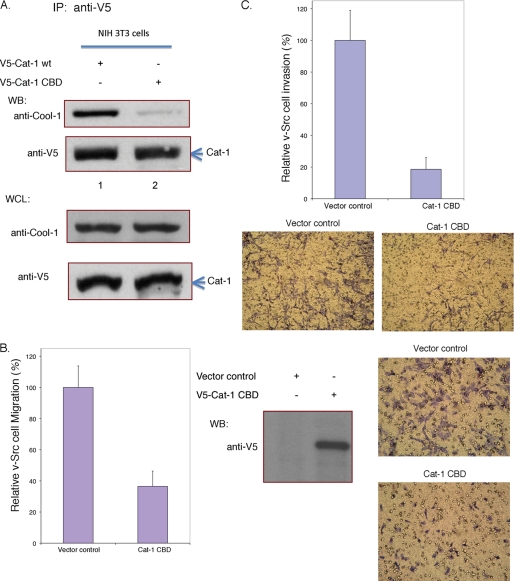FIGURE 7.
The Cool-1-Cat interaction is important for the migration and invasive activity of v-Src-transformed NIH 3T3 cells. A, NIH 3T3 cells were transfected with V5-tagged wild-type Cat-1 or with the V5-tagged, Cool-1 binding-defective Cat-1 double-mutant (Cat-1 CBD). Top panels, Cat-1 was immunoprecipitated with the anti-V5 antibody, and the immunocomplexes were probed with an anti-Cool-1 antibody or with an anti-V5 antibody. Bottom panels, shown are the relative amounts of endogenous Cool-1 and V5-Cat-1 CBD in the whole cell lysates. B, viral-Src-transformed NIH 3T3 cells were transfected with an empty vector (control) or with V5-tagged Cat-1 CBD. The cells were cultured for 24 h and then scored for their ability to migrate as described in the legend to Fig. 1. Left panel, the results from three experiments were averaged and plotted. The error bars indicate ± S.D. Middle panel, cell lysates were subjected to Western blot analysis to assess the expression of V5-Cat-1 CBD. Right panels, microscopic images were obtained for the migration assays shown on the left. The cells are visualized by GIEMSA staining (dark purple). The clear circles represent holes in the filters. C, viral-Src-transformed NIH 3T3 cells were transfected with empty vector or with V5-tagged Cat-1 CBD. These cells were cultured for 24 h and then scored for invasiveness as described in the legend to Fig. 4B. Top panel, results from three experiments were averaged and plotted. The error bars indicate ± S.D. Bottom panels, microscopic images of the invasion assays are shown. The cells are visualized by GIEMSA staining (dark purple).

